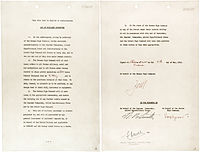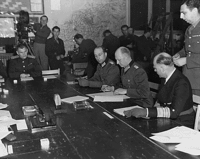Almanya'nın teslimiyet belgesi: Revizyonlar arasındaki fark
| [kontrol edilmiş revizyon] | [kontrol edilmiş revizyon] |
k ufak düzenlemeler |
|||
| 1. satır: | 1. satır: | ||
[[Dosya:German instrument of surrender2.jpg|right|thumb|200px|7 Mayıs 1945 tarihinde Reims'da imzalanan Almanya'nın teslimiyet belgesi]] |
[[Dosya:German instrument of surrender2.jpg|right|thumb|200px|7 Mayıs 1945 tarihinde Reims'da imzalanan Almanya'nın teslimiyet belgesi]] |
||
'''Almanya'nın teslimiyet belgesi''', [[II. Dünya Savaşı]]'nın Avrupa Cephesi'ni kapatmak için bir mütarekeyi sağlayan hukukî anlaşma belgesidir. |
'''Almanya'nın teslimiyet belgesi''', [[II. Dünya Savaşı]]'nın Avrupa Cephesi'ni kapatmak için bir mütarekeyi sağlayan hukukî anlaşma belgesidir. |
||
Teslimiyet belgesi [[Oberkommando der Wehrmacht]], [[Müttefik Sefer Kuvvetleri]] (Allied Expeditionary Force) ve [[Sovyet Sosyalist Cumhuriyetler Birliği|Sovyetler Birliği]] Yüksek Komutanlığı tarafından 7 Mayıs 1945 tarihinde imzalanıp 8 Mayıs 1945 tarihinde yürürlüğe girdi. Bu tarih Batı Dünyasında [[V-E Day]] (Avrupa Zafer Günü) olarak bilinir. |
Teslimiyet belgesi [[Oberkommando der Wehrmacht]], [[Müttefik Sefer Kuvvetleri]] (Allied Expeditionary Force) ve [[Sovyet Sosyalist Cumhuriyetler Birliği|Sovyetler Birliği]] Yüksek Komutanlığı tarafından 7 Mayıs 1945 tarihinde imzalanıp 8 Mayıs 1945 tarihinde yürürlüğe girdi. Bu tarih Batı Dünyasında [[V-E Day]] (Avrupa Zafer Günü) olarak bilinir. |
||
| 48. satır: | 48. satır: | ||
[[Dosya:Wilhelm Keitel Kapitulation.jpg|right|thumb|[[Field Marshal]] [[Wilhelm Keitel]] signing the ratified surrender terms for the German military in Berlin.]] |
[[Dosya:Wilhelm Keitel Kapitulation.jpg|right|thumb|[[Field Marshal]] [[Wilhelm Keitel]] signing the ratified surrender terms for the German military in Berlin.]] |
||
A second Act of Military Surrender was signed shortly after midnight Central European time on May 8<ref>Earl F. Ziemke [[#References|References]] [http://www.globalsecurity.org/military/library/report/other/us-army_germany_1944-46_ch15.htm#b3 CHAPTER XV:The Victory Sealed] Page 258 last paragraph</ref> at the seat of the Soviet Military Administration in [[Berlin]]-[[Karlshorst]], now the location of the [[German-Russian Museum Berlin-Karlshorst]]. [http://www.museum-karlshorst.de/]. |
A second Act of Military Surrender was signed shortly after midnight Central European time on May 8<ref>Earl F. Ziemke [[#References|References]] [http://www.globalsecurity.org/military/library/report/other/us-army_germany_1944-46_ch15.htm#b3 CHAPTER XV:The Victory Sealed] Page 258 last paragraph</ref> at the seat of the Soviet Military Administration in [[Berlin]]-[[Karlshorst]], now the location of the [[German-Russian Museum Berlin-Karlshorst]]. [http://www.museum-karlshorst.de/]. |
||
This ratification was a response to both Soviet and British concerns. The Soviets desired a signature in the presence of the Soviet Supreme Commander (Major General Susloparov, who had accepted the May 7 surrender for the Soviets, was only liaison officer at the Western Headquarters). The British wanted the surrender to be signed by the highest military and civilian representatives of the German Reich, in order to avoid a repeat of the "stab in the back" legend which had been cultivated by the Germans after World War I because the armistice had been signed only by a civilian politician and an unknown general. (Jodl, who signed in Rheims, was an officer without the power of command). Since the Dönitz led [[Flensburg government|government based in Flensburg]] was not recognized{{Citation needed|date=November 2009}}, it was agreed to have the May 7 act ratified with the signatures of the commanders in chief of the Wehrmacht, army, air force and marines, who were brought to Karlshorst, the seat of the Soviet Supreme Commander. The representatives of the Western Headquarters, the United Kingdom, France and the United States entered the dining room of the officers' mess in Karlshorst shortly before midnight. The German delegation, which had been flown in from Flensburg to Tempelhof in a U.S. airplane, entered the room shortly after midnight after Marshal Georgy Zhukov, the Soviet representative, had opened the ceremony. The ratification of the German Act of Unconditional Surrender was signed around 00.15 o'clock, after its regulations had already been in effect for over an hour (23:01 Central European Time). |
This ratification was a response to both Soviet and British concerns. The Soviets desired a signature in the presence of the Soviet Supreme Commander (Major General Susloparov, who had accepted the May 7 surrender for the Soviets, was only liaison officer at the Western Headquarters). The British wanted the surrender to be signed by the highest military and civilian representatives of the German Reich, in order to avoid a repeat of the "stab in the back" legend which had been cultivated by the Germans after World War I because the armistice had been signed only by a civilian politician and an unknown general. (Jodl, who signed in Rheims, was an officer without the power of command). Since the Dönitz led [[Flensburg government|government based in Flensburg]] was not recognized{{Citation needed|date=November 2009}}, it was agreed to have the May 7 act ratified with the signatures of the commanders in chief of the Wehrmacht, army, air force and marines, who were brought to Karlshorst, the seat of the Soviet Supreme Commander. The representatives of the Western Headquarters, the United Kingdom, France and the United States entered the dining room of the officers' mess in Karlshorst shortly before midnight. The German delegation, which had been flown in from Flensburg to Tempelhof in a U.S. airplane, entered the room shortly after midnight after Marshal Georgy Zhukov, the Soviet representative, had opened the ceremony. The ratification of the German Act of Unconditional Surrender was signed around 00.15 o'clock, after its regulations had already been in effect for over an hour (23:01 Central European Time). |
||
Sayfanın 08.36, 4 Mayıs 2014 tarihindeki hâli

Almanya'nın teslimiyet belgesi, II. Dünya Savaşı'nın Avrupa Cephesi'ni kapatmak için bir mütarekeyi sağlayan hukukî anlaşma belgesidir.
Teslimiyet belgesi Oberkommando der Wehrmacht, Müttefik Sefer Kuvvetleri (Allied Expeditionary Force) ve Sovyetler Birliği Yüksek Komutanlığı tarafından 7 Mayıs 1945 tarihinde imzalanıp 8 Mayıs 1945 tarihinde yürürlüğe girdi. Bu tarih Batı Dünyasında V-E Day (Avrupa Zafer Günü) olarak bilinir.
Teslimiyet belgesinin Almanca, İngilizce ve Rusça olmak üzere üç dil sürümü vardı. Sadece İngilizce ve Rusça sürümlerinin yetkisi vardı. İngilizce sürümü, Susan Hibbert tarafından daktilo ile yazılmıştır.
Rheims'deki töreni

Teslimiyet belgesi, Orta Avrupa Zaman Dilimi'ne göre 7 Mayıs 1945 tarihinde saat 02:41'de Fransa'nın Rehims şehrinde (Marne, Champagne-Ardenne) Müttefik Sefer Kuvvetleri Yüksek Karargâhı (SHAEF)'nın bulunduğu kırmızı tuğlalı okul binasında imzalandı[1] ve Orta Avrupa Zaman Dilimi'ne göre 8 Mayıs 1945 tarihinde saat 23:01'de yürürlüğe girdi.[2]
Almanya'nın silahlı kuvvegtlerinin Müttefiklere karşı kayıtsız şartsız teslimiyeti Oberkommando der Wehrmacht için ve yeni Devlet Başkanı Karl Dönitz'in temsilcisi olarak Generaloberst Alfred Jodl, Batı Müttefikleri temsilen Walter Bedell Smith, Sovyetleri temsilen İvan Susloparov, resmî tanık olarak Fransız Tümgeneral François Sevez imzaladı.
Ayrıca bakınız
 |
|
| Dinlerken sorun mu yaşıyorsunuz? Medya yardımı alın. | |
Refarens
| Wikimedia Commons'ta Almanya'nın teslimiyet belgesi ile ilgili ortam dosyaları bulunmaktadır. |
- http://www.dw-world.de/dw/article/0,1564,1577141,00.html
- Earl F. Ziemke "The U.S. Army in the occupation of Germany 1944-1946" Cenrer of Military History, United States Army, Washington, D. C., 1990, Library of Congress Catalog Card Number 75-619027
- The Memoirs of Georgy Zhukov. Chapter 22: Unconditional Surrender of Nazi Germany (Rusça)
Not
- ^ I remember the German surrender, Kathryn Westcott, BBC News, May 4, 2005.
- ^ Act of Military Surrender Signed at Rheims at 0241 on the 7th day of May, 1945, The Avalon Project, Yale University Law School, © 1996-2007, The Lillian Goldman Law Library in Memory of Sol Goldman.
